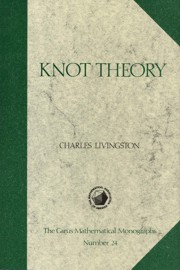Book contents
- Frontmatter
- ACKNOWLEDGEMENTS
- PREFACE
- Contents
- Chapter 1 A CENTURY OF KNOT THEORY
- Chapter 2 WHAT IS A KNOT?
- Chapter 3 COMBINATORIAL TECHNIQUES
- Chapter 4 GEOMETRIC TECHNIQUES
- Chapter 5 ALGEBRAIC TECHNIQUES
- Chapter 6 GEOMETRY, ALGEBRA, AND THE ALEXANDER POLYNOMIAL
- Chapter 7 NUMERICAL INVARIANTS
- Chapter 8 SYMMETRIES OF KNOTS
- Chapter 9 HIGH-DIMENSIONAL KNOT THEORY
- Chapter 10 NEW COMBINATORIAL TECHNIQUES
- Appendix 1 KNOT TABLE
- Appendix 2 ALEXANDER POLYNOMIALS
- REFERENCES
- INDEX
Chapter 7 - NUMERICAL INVARIANTS
- Frontmatter
- ACKNOWLEDGEMENTS
- PREFACE
- Contents
- Chapter 1 A CENTURY OF KNOT THEORY
- Chapter 2 WHAT IS A KNOT?
- Chapter 3 COMBINATORIAL TECHNIQUES
- Chapter 4 GEOMETRIC TECHNIQUES
- Chapter 5 ALGEBRAIC TECHNIQUES
- Chapter 6 GEOMETRY, ALGEBRA, AND THE ALEXANDER POLYNOMIAL
- Chapter 7 NUMERICAL INVARIANTS
- Chapter 8 SYMMETRIES OF KNOTS
- Chapter 9 HIGH-DIMENSIONAL KNOT THEORY
- Chapter 10 NEW COMBINATORIAL TECHNIQUES
- Appendix 1 KNOT TABLE
- Appendix 2 ALEXANDER POLYNOMIALS
- REFERENCES
- INDEX
Summary
A few methods for associating integers to knots have already appeared in the text. The genus is an important example. Others include the signature, the determinant, and the mod p rank. In this chapter many more will be described. Some of these will seem to be very natural quantities to study. Others, such as the degree of the Alexander polynomial, may at first seem artificial; it is the relationship between these invariants and the more natural ones that is particularly interesting and useful.
It will be clear in this chapter that with the introduction of each new invariant a host of questions arises concerning its relationship with other invariants. Some of these questions will be discussed, others will be presented in the exercises. A few open questions will appear along the way.
Summary of Numerical Invariants
Several knot invariants have been defined so far. These are reviewed in this section. In the next sections many new invariants will be described.
GENUS
Every knot forms the boundary of an oriented surface called a Seifert surface of the knot. The genus of a knot, g(K), is the minimal genus that occurs among all Seifert surfaces. Only the unknot has genus 0; the pretzel knots form an infinite family of genus 1 knots. The proof of the prime decomposition theorem was based on the result that genus is additive under connected sum.
- Type
- Chapter
- Information
- Knot Theory , pp. 129 - 150Publisher: Mathematical Association of AmericaPrint publication year: 1993



